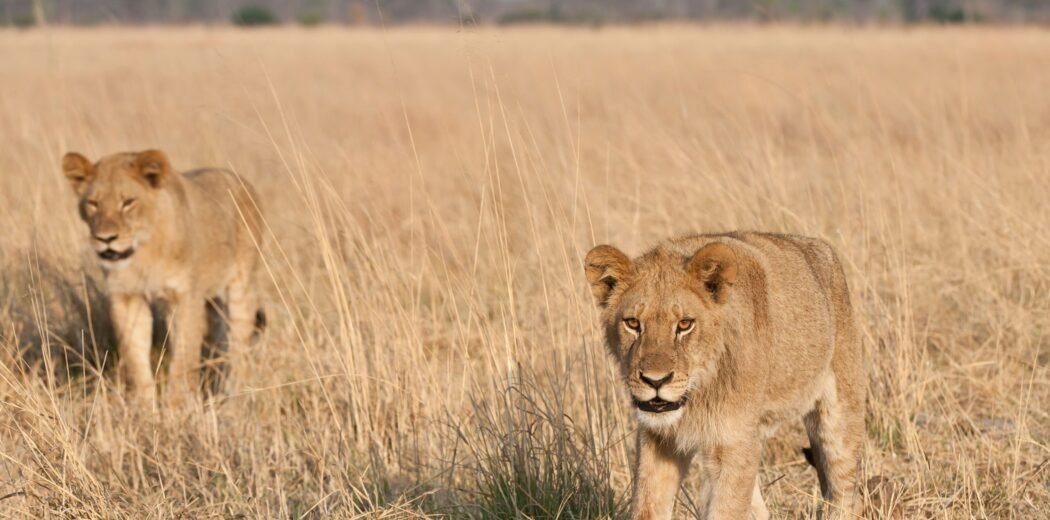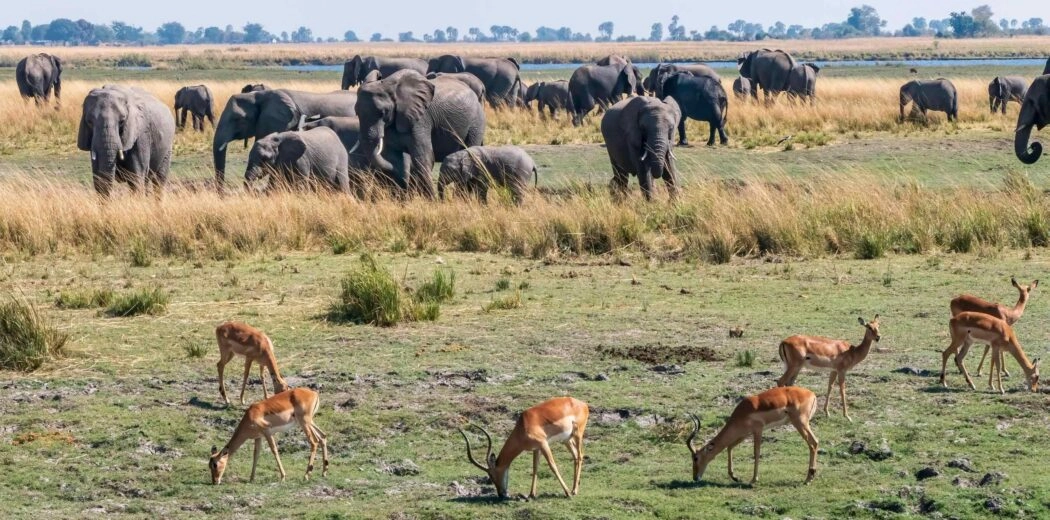Zimbabwe is often overlooked as a safari destination but its untouched wilderness is rife with incredible landscapes and fantastic wildlife.
With abundant game territories, exceptional guiding and a variety of endangered species, Zimbabwe’s wildlife spotting opportunities are unrivalled.
From the UNESCO-protected Mana Pools National Game Park to the untamed Gonarezhou, this is our guide on where to see wildlife in Zimbabwe.

Hwange National Park
Zimbabwe’s largest national park, Hwange, is a land mass of over 14,000 square kilometres brimming with over 100 mammals and 400 bird species. Sought-after species are not uncommon here, as the park is home to over 20,000 elephants and the largest population of African wild dog in the world. Large prides of lion and buffalo also reside here, as well as leopards, rhinos, cheetahs and spotted hyenas. The best time to visit Hwange for its wildlife is from June to October. During these months, the wildlife is concentrated around waterholes and is therefore far easier to spot than during other months.

In this wildlife haven, there are two standout camps that allow you to get up close to the animals. At the newly refurbished Linkwasha Camp, guests can spend a night on Linkwasha’s Star Bed. This bed on a raised platform is just a short distance from the camp and only a mosquito net separates campers from the surrounding wilderness. The outdoor gem overlooks the Scott’s Pan watering hole, so guests are guaranteed incredible wildlife sightings.

If you’re not convinced by spending the entire night outdoors, you can take solace in the fact that a local guide is only a short distance away should you need any assistance. There is an abundance of wildlife in this area, including rarer species such as sable antelopes, blue wildebeests and impalas. During the summer months, wildebeests, zebras and elands roam freely around the open plains, while in winter, elephants congregate in large numbers around watering holes.

For those looking for a more traditional safari experience, The Hide Safari Camp doesn’t disappoint. This camp is also great for families, as Tom’s Little Hide Cottage accommodates up to six adults and four children. During a stay here, guests can spot wildlife in a more conventional manner of game drives and bush walks. On these excursions, safari goers can expect to see herds of elephants, buffalos, lions, leopards and African wild dogs, as well as some 400 bird species.


Mana Pools National Game Park
UNESCO-protected Mana Pools National Game Park is one of the wildest areas in Zimbabwe. Much of this expansive parkland is only accessible on foot, so the area’s natural beauty remains relatively untouched. “Mana,” meaning “four” in the local language, refers to the four large pools that lie inland here. These pools are remnant ox-bow lakes, carved by the Zambezi River thousands of years ago.

Wildlife surrounds these water bodies, with the pools attracting a plethora of aquatic birds, as well as herds of elephants, hippos and Nile crocodiles. On dry land, safari goers can find lions, leopards, cheetahs and spotted hyenas. These predators are mostly found in the reserve’s open woodlands but tend to be secretive, so it’s worth going with an expert tracker. The low scrub here makes Mana Pools an excellent walking destination, so wildlife can be spotted either on foot or from canoes in the pools.

The best place to stay for wildlife sightings in Mana Pools is Ruckomechi Camp. The luxurious tents here were built near albida trees, favoured by elephants. It’s not unheard of for herds of elephants to spend most of their days here, so guests can view these majestic animals without even having to leave their lodge. Birdwatching enthusiasts can enjoy the wealth of birds in the area, with notable species including the snake-eagle, three-banded courser, Arnot’s chat, African golden oriole and Meve’s starling. Of course, the spectacular Big Five can also be seen here; there are opportunities to spot leopards, hippos, Burchell’s zebra, lions and buffalos on river cruises, game drives and nature walks.


Gonarezhou National Park
An unbelievably wild terrain, Gonarezhou National Park is known as the “place of the Elephants.” Despite being the second largest park in the country, it is the least visited, making it extremely appealing to travellers looking to go on safari in true solitude. This wild land belongs to the elephants – about 8,000 reside here and they are rarely disturbed by humans. Three rivers meet in this park – the Save, Runde and Mwenezi – so it’s also the perfect habitat for a variety of birds, fish and antelope species (including the rare roan). With the help of expert trackers, lions, leopards, African wild dogs and cheetahs can be spotted here too. As the terrain is challenging to navigate and the wildlife is elusive, Gonarezhou is suited to more avid safari goers.

Run by award-winning conservationist pioneer Clive Stockil, Chilo Gorge Safari Lodge is the best property in the region. Clive was awarded the prestigious 2013 Tusk Lifetime Achievement Award for Conservationism and it is reflected in his work here. The team of expert guides and trackers here have an unparalleled knowledge of the area, and the activities on offer are outstanding. While staying here, guests can take part in daily game drives and animal tracking or stay overnight in the lodge’s tented camp deep in the wilderness.


Malilangwe Wildlife Reserve
As the name suggests, Malilangwe Wildlife Reserve is one of the largest bio-refuges across Africa. Untouched Mopane forest gives way to sandstone hills and winding creeks in this area of outstanding natural beauty, so some of the most authentic safari opportunities across Zimbabwe are on offer here. This fascinating region is home to some of the highest concentrations of black rhino in Africa, as well as the Big Five, sable antelopes and roans. Malilangwe also offers the opportunity to learn about Zimbabwe’s culture and ancient history, as there are over a hundred bushman rock sites – dating back over 2,000 years – to explore.

Perched overlooking the Chiredzi River, Singita’s Pamushana Lodge is the perfect place from which to explore the wild. Thatched buildings blend into the surrounding trees and open-sided dining areas offer far-reaching views. Aside from all the usual Singita amenities, there are plenty of wildlife-related excursions available. Guests can take part in game drives with professional guides, walking safaris, boat cruise safaris, spot-lit night drives and black rhino tracking. For a glimpse into human life, travellers can visit the San bushmen rock art sites or respectfully tour the local community.

Explore our favourite wildlife trips to Zimbabwe
Feeling inspired? Our expert travel designers are always on hand to help you plan your tailored wildlife trip to Zimbabwe.





